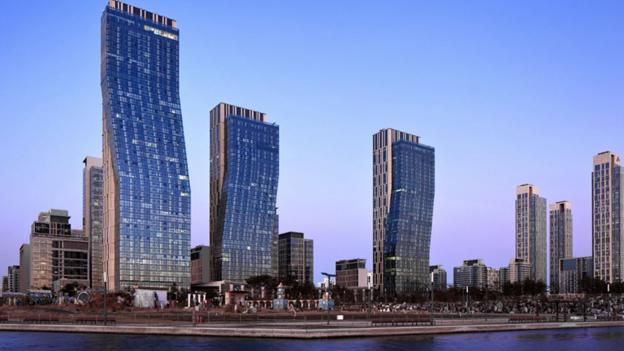Why purpose-built cities may not solve living problems
What’s better, living in a new city raised from the ground or in an existing city that’s free to adapt? Here’s where designers and dwellers disagree.
Related
Pleasure principle
Can cities make you happy?
(Thinkstock)
Dirty tricks of city design
Plugged in
Smarter cities, smarter future
Greener thinking
Green wonder: Your park in 2050
GM EN-V concept
What will we be driving in 2050?
How well do you know the world? Play Geoguessr to find out!
How well do you know the world?
Think you’re a geography expert? Test your knowledge with BBC Travel’s Geoguessr game.
Wandering the streets of Songdo is supposed to be a pleasant experience. The South Korean city boasts streets that are clean and spacious. There is little traffic, and no cars lining the roadside – they are all parked underground. Gleaming tower blocks rise around a central park, and everything you need is a short walk away. There are no garbage trucks either: rubbish dropped into bins is sucked into pneumatic tubes sent off to be processed. And its environmental credentials are a talking point too. As well as freshwater and sewer pipes, a grey water system recycles wastewater. And this is the poster-child smart city, perfused in electronic infrastructure, interlaced with high-speed data fibres, and peppered with sensors that monitor everything from traffic conditions to fire alarms.
What Songdo lacks is any history. It is a purpose-built city built on reclaimed land, a business hub that crystallised out of the Yellow Sea as a conurbation of neighbouring Incheon. So is Songdo’s 21st-Century city a preview of what’s to come for the rest of us. Is this the blueprint of the future?
“I can't see that Songdo is any meaningful way a model for the future, except possibly a clumsily-written dystopia,” says Adam Greenfield, author of Against the Smart City. “It's very little other than a conventional commercial real-estate proposition – though achingly pretentious, and perhaps less successful than most.”
He may have a point. Visionary cities conjured from the imaginations of master builders are nothing new. And though the prospect of building a city entirely from scratch is appealing, a clean break from the past is no guarantee of long-term fit for the future. The dream visions that became Brasilia, Milton Keynes, and Adelaide all achieved a reasonable level of success, but for each of these there is somewhere like Palmanova, the ideal Italian town built in 1593 that proved so unpopular pardons were offered to any criminal willing to move in.
“I myself would be very unlikely to build a city from scratch,” says Greenfield. “I think it's a very bad idea from the start: wasteful of the Earth, destructive of the integrity of the ecosystem, wasteful of resources. There's plenty of room for densification of existing urbanised sites.”
Purpose-built cities have come into vogue in recent years, but without much in the way of success. In Abu Dhabi, British architectural firm Fosters and Partners have started work on Masdar City, a zero-carbon aerotropolis built in the desert, but plans for futuristic self-driving electric pods and a cool undercroft (below-ground area) have already been shelved. India’s privately built Lavasa is a boutique city, designed to resemble the Italian town of Portofino, has become mired in controversy and bureaucratic wrangling. And the much-vaunted smart city promised by the PlanIT initiative in Portugal has yet to see a single stone laid – smart or otherwise.
The disjointed relationship between the people who design cities and the people who have to live in them is a recurring problem. The traffic-free streets of Songdo owe more to a lack of citizens than a lack of cars. Authorities aren’t mailing out pardons to Korean prisoners yet, but the city is struggling to attract residents. “The primary threat in masterplanning is as it ever was: that the masterplan will completely fail to account for fundamental shifts in social or technological practice,” says Greenfield, “literally setting in concrete notions about personal mobility or work that are live, dynamic, open questions.” The most obvious of those was the explosive growth of personal car ownership, a trend that has strangled cities from New York to Shanghai.
Source; http://www.bbc.com/
Subscribe to:
Post Comments (Atom)


No comments:
Post a Comment